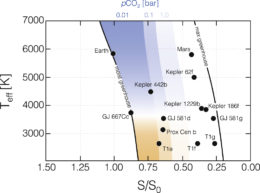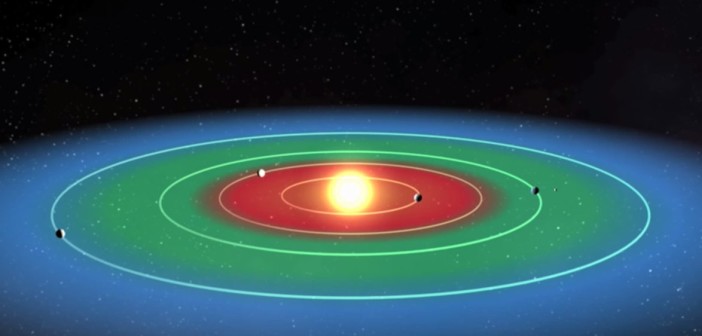Editor’s note: In these last two weeks of 2019, we’ll be looking at a few selections that we haven’t yet discussed on AAS Nova from among the most-downloaded papers published in AAS journals this year. The usual posting schedule will resume in January.
A Limited Habitable Zone for Complex Life
Published June 2019
Main takeaway:
A team of scientists led by Edward Schwieterman (UC Riverside) has demonstrated that the habitable zone — the range of orbital distances around its host star at which a planet can support life — becomes significantly narrower when exploring where complex life can exist, as opposed to just microbial life.

Some constraints on the habitable zone, with a few sample exoplanets plotted for reference. The darkest blue region shows where risk of CO2 and CO toxicities are lowest and a planet would be most likely to be able to support complex life. [Schwieterman et al. 2019]
Why it’s interesting:
By identifying planets that lie in their host stars’ habitable zones, we can narrow down our list of targets in our search for life beyond Earth. But traditionally, “habitable zone” merely refers to the range of distances at which a planet can support liquid water — and this definition ignores the many additional constraints that could limit the ability of different life forms to exist on a planet. Schwieterman and collaborators’ work explores one of those constraints by considering what orbital distances would result in a buildup of toxic gases — carbon monoxide and carbon dioxide — in the atmospheres of planets that would make them unfit for complex life as we know it.
Why this significantly limits our options:
Schwieterman and collaborators’ work indicates that carbon dioxide toxicity alone limits the habitable zone for simple animal life to half of the traditional habitable zone around a Sun-like star, and that region shrinks to less than a third of the traditional habitable zone for more complex life like humans. In addition, carbon monoxide toxicity is a significant problem for planets that receive a large amount of ultraviolet radiation — like those orbiting M dwarfs. This suggests that the entire habitable zones of M-dwarf stars may be ruled out in the search for some complex life.
Citation
Edward W. Schwieterman et al 2019 ApJ 878 19. doi:10.3847/1538-4357/ab1d52
